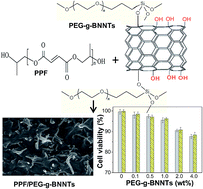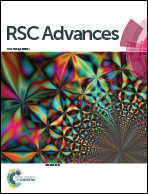PEGylated boron nitride nanotube-reinforced poly(propylene fumarate) nanocomposite biomaterials
Abstract
Boron nitride nanotubes (BNNTs) are amongst the most promising inorganic nanomaterials explored so far. Aiming to attain polymeric biomaterials with tailored physical properties for tissue engineering, polyethylene glycol (PEG)-grafted BNNTs were used as reinforcements for biocompatible poly(propylene fumarate) (PPF). The nanocomposites were synthesized via sonication and thermal curing, and their morphology, hydrophilicity, biodegradability, cytotoxicity, thermal, mechanical, tribological and antibacterial properties were examined. Morphological observations revealed that the PEG-g-BNNTs were randomly and uniformly dispersed within PPF, and suggested good compatibility between the covalently functionalized nanotubes and the matrix. The thermal stability, hydrophilicity, water uptake, biodegradation rate and protein absorption capability gradually increased upon increasing PEG-g-BNNTs loading. The nanocomposites displayed superior stiffness and strength compared to PPF, and maintained enough rigidity under physiological conditions to be used for bone tissue regeneration. The friction coefficient and wear rate decreased upon addition of the PEG-g-BNNTs, which is desirable for biomedical applications. The nanocomposites exhibited antibacterial activity against Gram-positive S. aureus and Gram-negative E. coli bacteria, the biocide effect being stronger with increasing nanotube loading, and did not cause toxicity on human dermal fibroblasts.


 Please wait while we load your content...
Please wait while we load your content...